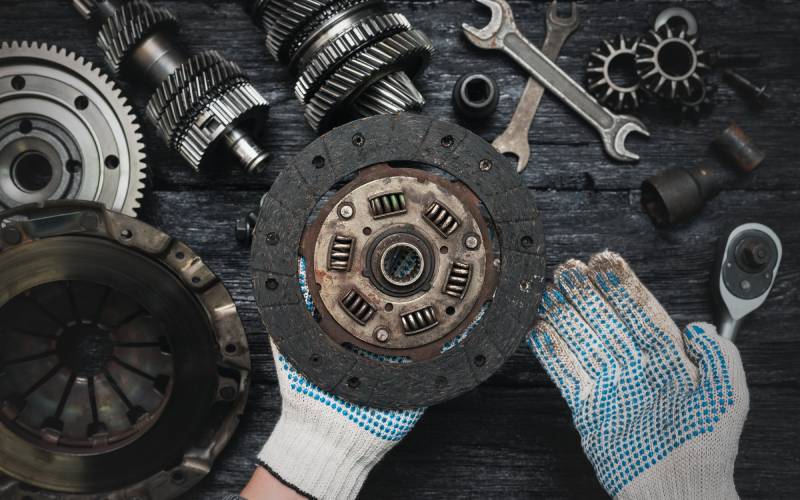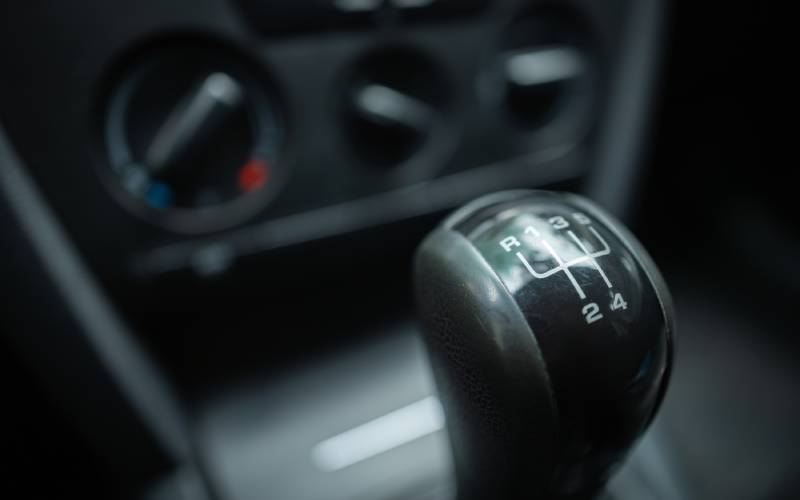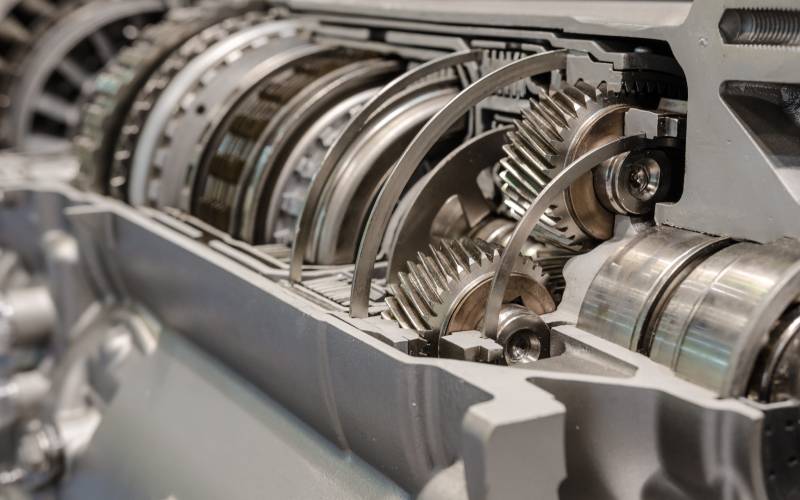The Evolution of the Manual Clutch Transmission

The manual clutch transmission has long been an iconic component of automotive history. Driving purists and enthusiasts revere the manual clutch as the ideal form of driving as it represents the strongest connection between driver and machine.
From its early days as a revolutionary system for transferring power to its more current niche appeal, the manual transmission tells a story of engineering ingenuity and evolving preferences. Below, we’re going to take a deep dive into the history and evolution of the manual clutch transmission, from its simple origins to its modern advancements.
Early Days of the Manual Transmission
The history of manual clutch transmissions began in the late 19th and early 20th centuries, during the early days of automobiles. Back then, gear systems were basic and relied on large levers to manually engage gears—far from the sophisticated systems we know today.
Panhard's Sliding Gear Innovation
In 1891, French inventor Louis-René Panhard introduced one of the earliest manual gear systems, the sliding gear transmission. It featured a rudimentary clutch mechanism to disengage engine power during gear shifts. While primitive by today’s standards, this invention was a key step away from simple belt-driven transmissions toward more precise multi-gear systems.
In the 20th century, the automobile truly took hold as the dominant form of transportation in many parts of the world—particularly the United States. Cars advanced by leaps and bounds in just a handful of years, along with their transmissions by the 1920s.
The 20th Century Synchromesh Revolution
In 1928, Cadillac introduced the first synchromesh transmission, which allowed smoother gear changes without grinding. This innovation made driving even more accessible and easier for regular people.
Synchromesh designs were just the beginning of the many advancements manual transmissions saw in the 20th century. Engineers began experimenting with lighter materials, stronger components, and more efficient clutch mechanisms. By the mid-20th century, the single-disc dry clutch became the standard for cars as it offered better durability and easier maintenance compared to older systems.
Advances in Materials and Components
Improvements in metallurgy and manufacturing led to stronger, more durable parts. High-performance materials like ceramic and Kevlar, which could handle more friction and heat, slowly replaced steel clutch discs. Eventually, hydraulic clutch actuation systems also became more common, making operation smoother and more streamlined.

Modern Gearbox Design: Efficiency and Weight Reduction
The evolution of the manual clutch transmission took a turn towards lightweight materials and greater efficiency in the modern era. These innovations create more responsive and lightweight systems, enhancing the overall driving experience.
The introduction of five-speed and six-speed gearboxes in the 1970s and 1980s revolutionized manual transmissions. These configurations provided greater driving flexibility, better fuel efficiency, and improved high-speed performance over older three-speed designs.
Popularity and Decline of Manual Transmissions
Throughout much of the 20th century, manual transmissions were the standard in cars worldwide. They offered drivers an affordable, efficient, and reliable option, dominating both performance vehicles and economy cars. However, with advancements in automatic transmission technology, the manual transmission became rarer in standard vehicles.
The Rise of Automatic Transmissions
By the late 1990s and early 2000s, the popularity of manuals began to wane. Automatic transmissions, once seen as sluggish and inefficient, advanced significantly. Computer-controlled gearboxes and continuously variable transmissions (CVTs) closed the performance gap, offering smoother rides and greater convenience.
Challenges Facing Manual Transmissions Today
Manuals now struggle to compete in a market shaped by changing demands. Stricter emissions regulations, automakers catering to mainstream preferences, and modernized automatic systems have pushed manuals into a niche role.
Despite these challenges, manual transmissions retain a passionate following. Automotive enthusiasts value the sense of control and connection to the driving experience that only a manual can provide.
Advantages of Manual Transmissions
Despite their declining market share, manual transmissions remain a favorite for many driving enthusiasts. Among the many benefits of modern manual transmissions are greater driver control, fuel efficiency, and a more enjoyable driving experience.
Enhanced Control and Precision
Manual transmissions provide drivers with direct control over gear selection, offering unparalleled responsiveness and adaptability to road conditions. This hands-on approach allows for instant adjustments, whether you're climbing steep hills, navigating tricky terrain, or accelerating on a racetrack.
Unlike automatics, which rely on pre-programmed shifting patterns, manual transmissions let the driver stay in complete command. This precision enhances performance and gives an added sense of confidence and mastery behind the wheel.
Fuel Efficiency Benefits
Manual transmissions also offer fuel-efficiency benefits. By avoiding the energy loss from torque converters in traditional automatics, manuals deliver more power directly to the wheels. This direct power transfer often results in better fuel economy, especially for experienced manual drivers who know how to optimize their gear shifts.
The Joy of Driving
What truly sets manual transmissions apart is the driving experience they provide. Engaging the clutch, shifting gears, and mastering the art of timing create a deeper connection between the driver and the car. This active involvement transforms driving from a routine task into an engaging and rewarding activity.
For many enthusiasts, this connection elevates driving to an art form, making the driver not just a passenger in the vehicle’s operation but an integral, essential part of the journey. Manual driving offers a tactile, immersive experience that automatics can’t replicate, making it a timeless choice for those who truly love the road.

Understanding Clutch Systems: Single-Disc vs. Twin-Disc
The clutch system is a crucial part of manual transmissions, and the choice between single-disc and twin-disc clutches can make a world of difference in the performance, comfort, and drivability of your vehicle. Keep reading to understand the key differences between single and twin-disc clutches.
Single-Disc Clutches: Reliable for Everyday Use
Single-disc clutches are the most common type, using one friction disc pressed against a flywheel to transfer power. They are affordable, reliable, and perfect for standard driving needs. This setup provides smooth engagement, making it ideal for everyday vehicles.
Twin-Disc Clutches: Built for Heavy Loads and Performance
Twin-disc clutches feature two friction discs, doubling the surface area for power transfer. This design is for vehicles with high torque, such as race cars or trucks, as it handles heavier loads while reducing wear compared to single-disc systems.
Which is Better for My Car and Me?
The choice between single and dual-disc clutches ultimately depends on your vehicle's performance needs and how you plan to drive it. If you’re seeking a reliable, cost-effective solution for your daily commute or standard driving conditions, a single-disc clutch is a practical and efficient option.
However, for enthusiasts or professionals handling high-performance vehicles or towing heavy loads, a dual-disc clutch provides superior torque-handling capabilities, enhanced durability, and smoother engagement. Evaluating your vehicle's requirements and driving style is essential to selecting the clutch system that ensures optimal performance and longevity.
Upgrade Your Manual Clutch Transmission with Clutch Masters Industries
We hope you’ve enjoyed our tour through time of the manual clutch transmission, from its simple origins to its modern designs. If you need to replace or upgrade your vehicle’s clutch, you need a supplier you can trust, like Clutch Masters.
As reliable aftermarket flywheel manufacturers and clutch kit suppliers, we know everything about manual clutch transmissions. We specialize in high-performance and high-torque clutches for competitive racing and street cars. Browse our inventory online or contact our staff to speak with a clutch expert today.


